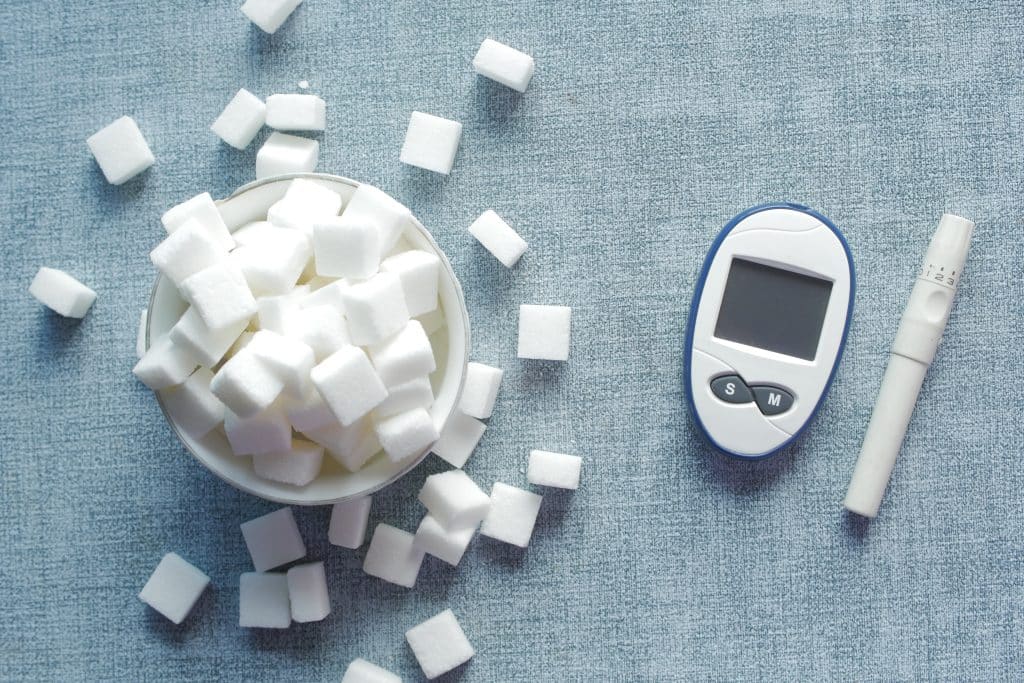Table of Contents
1. Introduction
In the realm of modern health dilemmas, sugar addiction stands out as a particularly insidious challenge. Often underestimated, the overconsumption of sugar is a significant contributor to a host of health problems including obesity, type 2 diabetes, heart disease, and even certain types of cancer. This article delves into an innovative approach to combatting this pervasive issue: the use of semaglutide, a medication originally developed for diabetes management, which shows promise in addressing sugar addiction.
The concept of sugar addiction is more than just a penchant for sweet treats. Scientifically, it’s the compulsive consumption of sugar-rich foods in a manner that mimics addictive behaviors associated with substances like nicotine and alcohol. Individuals grappling with sugar addiction often experience cravings, withdrawal symptoms, and a persistent desire to consume sweet foods, despite negative consequences.
Understanding sugar addiction requires a dive into the neurochemical underpinnings of the human brain. Sugar intake triggers the release of dopamine, a neurotransmitter associated with pleasure and reward. This dopamine surge reinforces the desire to consume sugar, creating a vicious cycle of cravings and consumption. Over time, the brain’s reward system becomes desensitized, necessitating higher sugar intake to achieve the same pleasurable effect, a hallmark of addictive behaviors.
Enter semaglutide, a glitide medication approved for type 2 diabetes treatment and more recently, for weight management. Its primary function is to mimic a hormone called glucagon-like peptide-1 (GLP-1), which regulates insulin secretion and appetite. However, emerging research suggests that semaglutide’s benefits may extend beyond glucose control and weight loss. Its potential role in curbing sugar addiction is a groundbreaking discovery, offering a new avenue for those struggling with this condition.
Semaglutide’s mechanism of action involves enhancing insulin secretion in response to increased blood glucose levels while simultaneously reducing appetite and food intake. This dual action not only assists in managing diabetes and promoting weight loss but also potentially mitigates the overpowering cravings associated with sugar addiction. By reducing the desire for sugar intake, semaglutide could be a game-changer in the fight against this form of addiction.
The exploration of semaglutide in the context of sugar addiction is a testament to the evolving understanding of both the condition and the medication. This article aims to provide a comprehensive guide to this novel approach, covering everything from the science behind sugar addiction to the intricacies of semaglutide’s effects, its benefits, potential risks, and practical considerations for those considering this treatment option.
In the following sections, we will delve deeper into the nature of sugar addiction, the therapeutic potential of semaglutide, and how it could revolutionize the approach to managing this challenging condition. We will explore the scientific evidence, hear from experts in the field, and consider the real-world implications for individuals seeking to overcome their dependence on sugar.
2. Understanding Sugar Addiction
Sugar addiction is a complex condition often overlooked in discussions about healthy eating and lifestyle. It is characterized by a compulsive need to consume sweet foods and beverages, leading to a cycle of cravings, indulgence, and often, guilt. This section aims to elucidate the nature of sugar addiction, exploring its symptoms, causes, and the biological mechanisms at play.
2.1 The Nature of Sugar Addiction
Sugar addiction is not merely a preference for sweet flavors but a physiological and psychological response to sugar. It shares characteristics with substance addictions, including intense cravings, loss of control over consumption, tolerance, and withdrawal symptoms. People with sugar addiction might find themselves consuming sweet foods even when they are not hungry, or in amounts that exceed their intended limit.
2.2 Symptoms and Indicators
The symptoms of sugar addiction are varied and can range from physical to psychological. Common indicators include:
- Intense cravings for sugary foods or drinks.
- Eating sugar or sweet foods even when not hungry.
- Experiencing withdrawal symptoms like headaches, irritability, or fatigue when reducing sugar intake.
- Continuing sugar consumption despite knowledge of its negative consequences.
- Repeated unsuccessful attempts to cut down or control sugar consumption.
2.3 Biological Mechanisms
Sugar stimulates the release of dopamine, a neurotransmitter responsible for feeling pleasure. This release creates a rewarding experience, encouraging repeat behavior. Over time, this can lead to a decreased response to dopamine, requiring more sugar to achieve the same pleasure level, a phenomenon known as tolerance.
Additionally, sugar consumption affects blood glucose levels, which can lead to a cycle of highs and crashes. These fluctuations can influence mood and energy levels, reinforcing dependence on sugar to maintain a sense of normalcy.
2.4 Psychological and Environmental Factors
The development of sugar addiction can also be influenced by psychological and environmental factors. Emotional stress, for instance, can lead to increased sugar cravings as individuals seek the comforting, mood-enhancing effects of sugar. Moreover, the omnipresence of sugar in the modern diet, often in hidden forms, contributes to unintentional overconsumption, perpetuating the cycle of addiction.
2.5 Health Implications
Chronic overconsumption of sugar is linked to various health issues, including obesity, type 2 diabetes, heart disease, and even certain cancers. Additionally, sugar addiction can lead to emotional distress, affecting overall mental health and well-being.
3. Semaglutide: An Overview
In the landscape of medical treatments for metabolic conditions, semaglutide emerges as a significant development. Originally approved for the management of type 2 diabetes, its potential applications have expanded, capturing the interest of those researching sugar addiction. This section provides a comprehensive overview of semaglutide, elucidating its nature, mechanism of action, and its journey from a diabetes drug to a potential tool in managing sugar cravings.
3.1 What is Semaglutide?
Semaglutide is a medication belonging to the class of drugs known as GLP-1 receptor agonists. It is a synthetic analog of the naturally occurring human hormone glucagon-like peptide-1 (GLP-1), which plays a vital role in glucose metabolism. It was initially developed and marketed under brand names like Ozempic and Rybelsus for the treatment of type 2 diabetes.
3.2 Mechanism of Action
The primary mechanism of action of semaglutide revolves around its ability to mimic the effects of GLP-1. GLP-1 is an incretin hormone, which means it is released in response to food intake and stimulates insulin secretion from the pancreas. This process helps lower blood sugar levels post-meals. Additionally, GLP-1 slows gastric emptying, promotes a feeling of fullness, and reduces appetite, which is particularly relevant in the context of weight management and potentially, sugar addiction.
3.3 Evolution from Diabetes Treatment to Weight Management
While semaglutide’s initial approval was for diabetes management, its impact on weight loss was soon recognized. In clinical trials, semaglutide demonstrated significant efficacy in reducing body weight, an effect attributed to its appetite-suppressing properties. This discovery led to its subsequent approval for weight management in individuals with obesity or overweight, with or without type 2 diabetes.
3.4 Theoretical Application to Sugar Addiction
The interest in semaglutide as a potential treatment for sugar addiction stems from its influence on appetite and food preference modulation. By reducing overall appetite and possibly altering food preferences, semaglutide could help individuals with sugar addiction reduce their cravings and intake of sugary foods. This approach is revolutionary, as it targets the physiological aspects of addiction, providing a new angle in the battle against sugar dependence.
3.5 Ongoing Research and Developments
Research into semaglutide’s efficacy in treating sugar addiction is ongoing. Early studies and anecdotal evidence suggest promising outcomes, but comprehensive clinical trials are needed to establish its effectiveness and safety in this specific application. Such research will not only broaden our understanding of semaglutide but also offer new insights into the mechanisms of sugar addiction.

4. The Link Between Semaglutide and Sugar Addiction
As the medical community ventures further into understanding sugar addiction, semaglutide stands out as a potential game-changer. This section delves into the connection between semaglutide and sugar addiction, exploring how this medication, originally intended for diabetes management, may hold the key to curbing sugar cravings and addiction.
4.1 Semaglutide’s Impact on Cravings and Appetite
The relationship between semaglutide and sugar addiction primarily hinges on the drug’s ability to modulate appetite and cravings. Semaglutide works by mimicking GLP-1, a hormone that reduces appetite. This effect is crucial for individuals with sugar addiction, as it can potentially decrease the overwhelming desire to consume sugary foods. By dampening appetite, semaglutide may help individuals gain better control over their eating habits, particularly their sugar intake.
4.2 Clinical Evidence Supporting Semaglutide’s Use in Sugar Addiction
While the primary use of semaglutide has been in diabetes management and weight loss, recent studies have begun to explore its impact on sugar addiction. Clinical trials have shown promising results, with participants reporting reduced cravings for sugary foods and an easier time adhering to diets lower in sugar. These findings suggest that semaglutide could be an effective tool in managing sugar addiction, offering a novel approach to a condition that has traditionally been challenging to treat.
4.3 Understanding the Neurological Effects
The effectiveness of semaglutide in managing sugar addiction may also be attributed to its neurological effects. By influencing the reward and pleasure centers in the brain that are stimulated by sugar consumption, semaglutide can alter the neurological response to sugar. This alteration could be a key factor in reducing the dependency on sugar for emotional and psychological satisfaction, addressing one of the core aspects of sugar addiction.
4.4 Bridging the Gap Between Physical and Psychological Dependence
Sugar addiction is not just a physical dependency; it has strong psychological components. Semaglutide’s potential to affect both physical and psychological aspects of sugar addiction makes it a particularly intriguing option. By reducing physical cravings and altering the brain’s response to sugar, it can provide a holistic approach to treatment, addressing the addiction on multiple fronts.
4.5 Case Studies and Personal Experiences
Anecdotal evidence and case studies further underscore the potential of semaglutide in managing sugar addiction. Individuals who have been prescribed semaglutide for diabetes or weight loss often report a notable decrease in their desire for sugary foods. These personal experiences, while not as scientifically rigorous as controlled trials, provide valuable insights into the real-world impact of semaglutide on sugar cravings.
5. The Benefits of Using Semaglutide for Sugar Addiction
The exploration of semaglutide as a treatment for sugar addiction is not only innovative but also potentially transformative for those grappling with this challenging condition. This section examines the various benefits of using semaglutide to manage sugar addiction, drawing from clinical research, patient testimonials, and the broader implications for health and wellness.
5.1 Reduced Cravings for Sugary Foods
One of the most significant benefits reported by users of semaglutide in the context of sugar addiction is a noticeable reduction in cravings for sugary foods. This effect can be a game-changer for individuals who struggle with constant sugar cravings, as it assists them in regaining control over their dietary choices. By diminishing the desire for sugar, semaglutide helps break the cycle of addiction, making it easier to adhere to healthier eating habits.
5.2 Weight Management and Improved Metabolic Health
For many battling sugar addiction, weight gain and associated metabolic issues are a major concern. Semaglutide, in reducing sugar intake and overall appetite, can play a crucial role in weight management. Its use has been linked to significant weight loss in clinical trials, primarily through decreased calorie intake and improved metabolic function. This weight loss can have a cascade of positive health effects, including lowered risk for diabetes, heart disease, and other weight-related conditions.
5.3 Enhanced Psychological Well-Being
The psychological impact of sugar addiction — such as feelings of guilt, lack of control, and low self-esteem — can be profound. Semaglutide’s role in curbing sugar addiction goes beyond physical health; it can also lead to enhanced psychological well-being. As individuals gain control over their sugar intake, they often report improvements in self-confidence, mood stability, and overall mental health.
5.4 Improved Glycemic Control in Diabetic Patients
For individuals with diabetes who also struggle with sugar addiction, semaglutide offers a dual benefit. It not only aids in managing sugar cravings but also improves glycemic control. This improvement is vital in reducing the risk of diabetes-related complications and enhancing the overall quality of life for diabetic patients.
5.5 Long-Term Health Benefits
The long-term health benefits of using semaglutide for sugar addiction cannot be overstated. By reducing sugar intake and improving dietary habits, individuals can lower their risk of developing chronic diseases such as obesity, type 2 diabetes, heart disease, and certain types of cancer. These long-term benefits extend beyond physical health, contributing to a more active, fulfilling, and healthier lifestyle.
6. Potential Risks and Side Effects
While semaglutide presents promising benefits in the management of sugar addiction, it is essential to consider its potential risks and side effects. This section provides a comprehensive overview of the drawbacks and challenges associated with semaglutide use, underscoring the importance of a cautious and informed approach to its adoption.
6.1 Gastrointestinal Side Effects
The most reported side effects of semaglutide are gastrointestinal in nature. These can include nausea, vomiting, diarrhea, constipation, and abdominal pain. These symptoms are typically mild to moderate and often diminish over time as the body adjusts to the medication. However, for some individuals, these side effects can be significant and may lead to discontinuation of the treatment.
6.2 Risk of Hypoglycemia in Diabetic Patients
For patients with diabetes, especially those on other glucose-lowering medications, there is a risk of hypoglycemia (low blood sugar levels) when using semaglutide. While semaglutide itself is not often associated with hypoglycemia, its combination with other diabetes medications can increase this risk. Careful monitoring of blood sugar levels and appropriate adjustments to medication dosages are necessary.
6.3 Pancreatitis and Gallbladder-Related Issues
There have been reports of acute pancreatitis in patients taking semaglutide, although the incidence is relatively rare. Symptoms of pancreatitis include severe abdominal pain, nausea, and vomiting. Additionally, gallbladder-related issues such as gallstones and cholecystitis have been observed. Patients with a history of pancreatitis or gallbladder disease should use semaglutide with caution and under close medical supervision.
6.4 Potential Effects on Heart Rate
An increase in heart rate has been noted in some individuals taking semaglutide. This effect warrants careful monitoring, particularly in patients with pre-existing heart conditions. Regular heart rate and rhythm monitoring are advised for those on semaglutide therapy.
6.5 Considerations for Specific Populations
Semaglutide is not recommended for use in certain populations, including pregnant women, individuals with a personal or family history of medullary thyroid carcinoma, or those with Multiple Endocrine Neoplasia syndrome type 2. The safety and efficacy of semaglutide in these groups have not been established.
6.6 The Importance of Professional Guidance
Given the potential risks and side effects, it is crucial that the use of semaglutide for sugar addiction is undertaken under the guidance of a healthcare professional. Personalized medical advice and regular monitoring can help mitigate risks and ensure the safe and effective use of the medication.

7. How to Get Started with Semaglutide
For individuals considering semaglutide as a potential treatment for sugar addiction, understanding the process of starting this medication is crucial. This section outlines the necessary steps and considerations for beginning semaglutide, providing guidance on obtaining a prescription, determining the appropriate dosage, and insights into the administration of the medication.
7.1 Consultation with a Healthcare Professional
The first and most important step in starting semaglutide is consulting with a healthcare professional. This consultation is essential to determine whether semaglutide is an appropriate treatment option based on individual health history, current medications, and the specific nature of the sugar addiction. The healthcare provider will conduct a thorough assessment, including medical history, physical examination, and possibly some laboratory tests, to ensure the safe use of semaglutide.
7.2 Obtaining a Prescription
Semaglutide is a prescription medication, and its use must be authorized by a healthcare provider. After a thorough evaluation, if semaglutide is deemed suitable, the healthcare professional will provide a prescription. It is important to discuss all potential risks, side effects, and expectations with the provider at this stage.
7.3 Recommended Dosages and Titration
The dosage of semaglutide is typically titrated, meaning it is gradually increased over time to minimize side effects and identify the most effective dose. Treatment usually starts with a low dose, which is incrementally increased based on the individual’s tolerance and response. Adhering to the prescribed dosage schedule is vital for the effectiveness and safety of the treatment.
7.4 Administration of Semaglutide
Semaglutide is administered as a subcutaneous injection, which can be self-administered after proper training from a healthcare provider. It is important to understand the correct technique for injection, including site rotation and syringe disposal. The medication is usually injected once a week, and consistency in the administration schedule helps maintain its effectiveness.
7.5 Monitoring and Follow-Up
Regular follow-up appointments with the healthcare provider are crucial when starting semaglutide. These appointments allow for monitoring of the treatment’s effectiveness, management of any side effects, and adjustments to the dosage if necessary. Patients should also be encouraged to monitor their sugar cravings and intake, as well as any changes in weight, appetite, or general health.
7.6 Addressing Concerns and Questions
Patients should feel comfortable discussing any concerns or questions they have about semaglutide with their healthcare provider. Open communication is key to a successful treatment plan, especially when dealing with a complex issue like sugar addiction.
Starting semaglutide for the treatment of sugar addiction involves a series of well-considered steps, from initial consultation to ongoing monitoring. The next sections will delve into lifestyle changes that can enhance the effectiveness of semaglutide, long-term management strategies for sugar addiction, and a conclusion summarizing the key points covered in this comprehensive guide.
8. Lifestyle Changes to Enhance Semaglutide's Effectiveness
While semaglutide can be a powerful tool in managing sugar addiction, its effectiveness is significantly enhanced when combined with appropriate lifestyle changes. This section explores the various lifestyle modifications that can support the treatment process, focusing on dietary adjustments, exercise, and mental health strategies.
8.1 Dietary Recommendations
A balanced and nutritious diet is fundamental in overcoming sugar addiction. When combined with semaglutide, a well-planned diet can help regulate blood sugar levels and reduce cravings. Key dietary recommendations include:
- Reducing Processed Sugars: Gradually cut down on foods high in processed sugars. This includes not just sweets and desserts, but also hidden sugars in sauces, dressings, and processed foods.
- Incorporating Whole Foods: Focus on whole, unprocessed foods such as fruits, vegetables, lean proteins, and whole grains. These foods provide essential nutrients and are more satisfying, which helps reduce cravings.
- Managing Portion Sizes: Be mindful of portion sizes to avoid overeating. Eating smaller, more frequent meals can help maintain stable blood sugar levels and prevent extreme hunger.
8.2 Exercise and Physical Activity
Regular physical activity is another crucial aspect of managing sugar addiction. Exercise not only aids in weight management but also improves insulin sensitivity and boosts mood. It can serve as a healthy alternative to cope with cravings and stress. Recommended activities include:
- Cardiovascular Exercise: Activities like walking, running, cycling, or swimming help burn calories and improve heart health.
- Strength Training: Building muscle mass through weight training can increase metabolism and improve body composition.
- Flexibility and Balance Exercises: Yoga and pilates can enhance flexibility, reduce stress, and improve overall well-being.
8.3 Mental Health Strategies
Addressing the psychological aspects of sugar addiction is just as important as the physical ones. Mental health strategies that can complement the use of semaglutide include:
- Mindful Eating: Practice being present and attentive during meals. Mindful eating helps recognize hunger and fullness cues, reducing the likelihood of overeating.
- Stress Management: Since stress can trigger sugar cravings, finding healthy ways to manage stress is vital. Techniques like meditation, deep breathing, and progressive muscle relaxation can be beneficial.
- Seeking Support: Whether it’s from a therapist, support group, or loved ones, having a support system can provide encouragement and accountability.
Combining semaglutide with these lifestyle changes offers a holistic approach to managing sugar addiction. By addressing dietary habits, physical activity, and mental health, individuals can maximize the benefits of semaglutide and move towards a healthier, more balanced lifestyle. The following sections will discuss long-term management strategies for sugar addiction and conclude with a summary of the key points addressed in this guide.
9. Long-Term Management of Sugar Addiction
Successfully overcoming sugar addiction with the aid of semaglutide is not just about achieving short-term goals; it’s also about implementing long-term strategies to maintain these achievements. This section focuses on sustainable approaches to managing sugar addiction over the long haul, ensuring that the progress made is not just temporary but a permanent lifestyle change.
9.1 Continuous Monitoring and Adjustment of Semaglutide
Long-term management often requires ongoing adjustments to the semaglutide dosage. As the body adapts or as weight and health goals are achieved, it may be necessary to modify the treatment plan. Regular consultations with a healthcare provider are essential for monitoring progress and making any necessary adjustments to the medication regimen.
9.2 Sustaining Dietary Changes
Maintaining the dietary changes introduced during the initial treatment phase is crucial. This involves:
- Consistent Healthy Eating Habits: Continued focus on a diet rich in whole foods, with limited processed sugars, is vital. Developing a long-term healthy relationship with food is more about balance and moderation than strict restriction.
- Adapting to Life Changes: As life circumstances change, dietary needs may also evolve. Being adaptable and making conscious food choices that align with current health goals is important.
9.3 Keeping Up with Physical Activity
Regular exercise should be a permanent fixture in one’s lifestyle, not just a temporary measure. This includes:
- Routine Physical Exercise: Establishing and adhering to a regular exercise routine that includes a mix of cardiovascular, strength, and flexibility training.
- Incorporating Physical Activity into Daily Life: Finding ways to be more active in daily life, such as taking stairs instead of elevators, walking or biking for short trips, and standing more often during the day.
9.4 Ongoing Mental and Emotional Support
The psychological component of sugar addiction remains significant over the long term. Continuing to engage in mental health strategies and seeking support when needed is essential. This might include:
- Regular Check-ins with Mental Health Professionals: For some, ongoing therapy or counseling can be beneficial in addressing underlying emotional or psychological factors contributing to sugar addiction.
- Support Networks: Staying connected with support groups or communities that understand and share similar experiences can provide encouragement and motivation.
9.5 Embracing a Holistic View of Health
Long-term management of sugar addiction means embracing a holistic view of health. This involves recognizing the interconnection between physical health, mental well-being, and emotional stability. It’s about making choices that benefit overall health and contribute to a fulfilling life. The long-term management of sugar addiction with semaglutide is a comprehensive process that encompasses medication management, dietary habits, physical activity, and psychological support. The final sections of this guide will summarize the key points and present a conclusion, providing a cohesive overview of the comprehensive approach to overcoming sugar addiction with semaglutide.

10. Conclusion
The journey through the complexities of sugar addiction and the exploration of semaglutide as a treatment option culminates in this concluding section. Here, we summarize the key insights and takeaways from our comprehensive guide, reflecting on the potential of semaglutide to revolutionize the approach to managing sugar addiction.
10.1 Recapitulation of Semaglutide’s Role
Semaglutide has emerged as a beacon of hope for those struggling with sugar addiction. Its ability to reduce cravings and appetite, a cornerstone in the battle against sugar addiction, marks it as a significant tool in this ongoing fight. Originally developed for diabetes management, its application in weight loss and potential in curbing sugar cravings underscores the versatility and efficacy of this medication.
10.2 The Importance of a Multifaceted Approach
Throughout this guide, it has become evident that managing sugar addiction requires a multifaceted approach. Semaglutide is a powerful ally, but its effectiveness is greatly enhanced when combined with dietary modifications, regular exercise, and mental health strategies. This holistic approach addresses not only the physiological aspects of addiction but also the psychological and behavioral components, providing a comprehensive strategy for overcoming sugar addiction.
10.3 Acknowledging the Challenges and Commitment Required
Overcoming sugar addiction is not an easy feat, and it requires a significant commitment to change. The journey is often marked by challenges and setbacks. However, the adoption of semaglutide, coupled with lifestyle changes and support, can make this journey more manageable and successful. It is a path that calls for patience, perseverance, and a willingness to adapt and grow.
10.4 The Role of Continuous Support and Self-Care
The importance of continuous support, be it medical, psychological, or communal, cannot be overstated. Regular check-ins with healthcare professionals, ongoing mental health support, and the solidarity of support groups are invaluable resources. Equally important is the role of self-care, including recognizing personal triggers, managing stress, and celebrating milestones, no matter how small they may seem.
10.5 Looking Forward
As research continues and our understanding of both sugar addiction and semaglutide deepens, the future holds promise for even more effective strategies in managing this condition. It is a dynamic field, and staying informed about new developments and treatment modalities will be crucial. “Semaglutide Unveiled: A Comprehensive Guide to Overcoming Sugar Addiction” has provided an in-depth look into sugar addiction and the potential of semaglutide as a treatment option. By understanding the complexities of this condition and embracing a comprehensive treatment approach, individuals struggling with sugar addiction can find hope and the possibility of a healthier, more balanced future.
10. Research Citations
Sugar addiction, characterized by excessive consumption of sugary foods and beverages despite negative consequences, has garnered increasing attention due to its potential impact on health. Understanding the mechanisms underlying sugar addiction is crucial for developing effective interventions and promoting healthier dietary behaviors. This article reviews current research on sugar addiction, including its neurobiological basis, behavioral manifestations, and clinical implications, providing insights into prevention and treatment strategies.
- Avena NM, Rada P, Hoebel BG. Evidence for sugar addiction: behavioral and neurochemical effects of intermittent, excessive sugar intake. Neurosci Biobehav Rev. 2008;32(1):20-39. doi:10.1016/j.neubiorev.2007.04.019
- Lustig RH, Schmidt LA, Brindis CD. Public health: The toxic truth about sugar. Nature. 2012;482(7383):27-29. doi:10.1038/482027a
- Gearhardt AN, Corbin WR, Brownell KD. Preliminary validation of the Yale Food Addiction Scale. Appetite. 2009;52(2):430-436. doi:10.1016/j.appet.2008.12.003
- Volkow ND, Wang GJ, Tomasi D, Baler RD. Obesity and addiction: neurobiological overlaps. Obes Rev. 2013;14(1):2-18. doi:10.1111/j.1467-789X.2012.01031.x
- Westwater ML, Fletcher PC, Ziauddeen H. Sugar addiction: the state of the science. Eur J Nutr. 2016;55(Suppl 2):55-69. doi:10.1007/s00394-016-1229-6
- Ahmed SH, Guillem K, Vandaele Y. Sugar addiction: pushing the drug-sugar analogy to the limit. Curr Opin Clin Nutr Metab Care. 2013;16(4):434-439. doi:10.1097/MCO.0b013e328361c8b8
- DiNicolantonio JJ, Berger A. Added sugars drive nutrient and energy deficit in obesity: a new paradigm. Open Heart. 2016;3(2):e000469. doi:10.1136/openhrt-2016-000469
- Benton D. The plausibility of sugar addiction and its role in obesity and eating disorders. Clin Nutr ESPEN. 2017;18:1-8. doi:10.1016/j.clnesp.2017.02.001
- Murray S, Tulloch A, Criscitelli K, Avena NM. Recent studies of the effects of sugars on brain systems involved in energy balance and reward: relevance to low calorie sweeteners. Physiol Behav. 2016;164(Pt B):504-508. doi:10.1016/j.physbeh.2016.04.029
- Volkow ND, Wise RA, Baler R. The dopamine motive system: implications for drug and food addiction. Nat Rev Neurosci. 2017;18(12):741-752. doi:10.1038/nrn.2017.130
These references offer a comprehensive overview of sugar addiction, including its neurobiological basis, behavioral manifestations, and clinical implications, providing valuable insights into prevention and treatment strategies.
Questions and Answers: Sugar addiction and semaglutide
The response to semaglutide can vary among individuals. Some might notice a reduction in sugar cravings within a few weeks, while for others, it may take longer. It’s important to have realistic expectations and understand that overcoming sugar addiction is a gradual process that involves both medication and lifestyle changes.
Semaglutide can be used with other medications, but it’s crucial to inform your healthcare provider about all medications you’re currently taking. This ensures the avoidance of potential drug interactions and allows for a safe and effective treatment plan.
While natural alternatives like dietary changes, exercise, and certain supplements may help manage sugar cravings, they often do not have the same efficacy as a medication like semaglutide. However, these natural methods are essential components of a comprehensive approach to treating sugar addiction.
If you experience side effects, it’s important to consult with your healthcare provider. They might adjust your dosage or suggest ways to manage the side effects. Do not stop taking semaglutide without medical advice.
Semaglutide can be an effective tool in managing sugar addiction, but it’s not typically considered a permanent solution. Long-term management often involves lifestyle changes and potentially ongoing treatment.
Compared to other treatments, semaglutide offers a unique approach by directly affecting appetite and cravings. It may be more effective for some individuals, especially those who struggle with significant cravings and have not found success with other methods.
While semaglutide is not a preventive treatment for diabetes, its ability to help manage weight and reduce sugar intake can indirectly lower the risk of developing type 2 diabetes in susceptible individuals.

Dr. Judith Germaine
Dr. Jude (Germaine-Munoz) Germaine, MD is a family physician in Springfield, New Jersey. She is currently licensed to practice medicine in New Jersey, New York, and Florida. She is affiliated with Saint Josephs Wayne Hospital.
